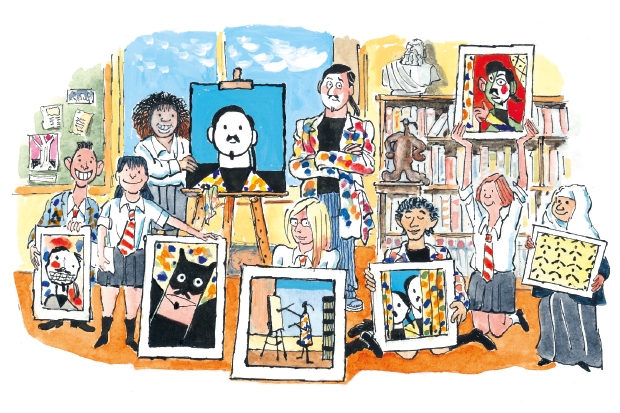Everything in the 21st-century developed world is something the 21st-century developed world believes it can monetise. Children, and their education, are most certainly not exempt from this paradigm.
Educationalists rarely tire of worrying about how the next generation are falling behind in just about everything compared with their equivalents in those pesky developing nations. Somewhere else in the world, countries are churning out prodigies, geniuses and work–ethically driven automatons who would rather kick in their own heads than kick a football if it meant missing an hour of maths tuition.
Naturally this is a concern when we rely on the next generation to invent, discover, build and deliver the things that will make us rich, secure and powerful. Hence, when faced with the opposite — a possible future nation of charmless, slack-jawed, texting, incurious youths who think Tennyson is a hiphop artist, and prime numbers a shop — we return increasingly to the ‘Something Must Be Done’ refrain.
Inevitably this means another debate about the importance of ramping up state and private sector investment in STEM subjects (science, technology, engineering and maths). Indeed the Royal Society has been making well-founded noises about the need to encourage CPD (continuing professional development) in every school, as there are currently far from enough resources to see this sensible policy through.
While concern about those skills is understandable, there is an elephant in the room. In fact, there’s an entire Billy Smart’s circus of them. This has less to do with how STEM subjects can help our global competitiveness, and more to do with the need for a child’s education to be well rounded.
Mention art, music and drama, and heads will nod as all manner of educationalist bollocks-speak begins to be muttered about how useful these subjects are as extracurricular diversions.
These subjects can, according to a pamphlet handed out to us at one secondary school, ‘enhance cultural connectivity amongst a diverse pupil population, and expand self-expression within the space of creative, individual-driven initiative.’ The question ‘Will my child also learn to draw a horse and play the piano?’ was dismissed — rightly, on that particular occasion — as facetiousness.
But the depressing reality is that the arts have been steadily shifted from being non-negotiable, essential components of the school curriculum to being regarded more as hobbies and diversions. We ignore this demotion at our peril. The arts were once cornerstones of learning; the ability to act, read music, play an instrument, sing communally, dance, was prized. These skills linked the physical with the philosophical, and broadened pupils’ horizons.
This is not to be nostalgic for some golden age of ‘The Muse’. (My memories of music lessons are mostly of the furious tweed-skirted teacher rapping her ruler on the desk until the class sang ‘Hearts of Oak Are Our Ships’ roughly in time.) But by removing this key component of learning, I do believe we are selling our children short.
The education revolution that moved from learning by rote and enforcing academic discipline to a culture of making learning ‘fun’ ironically contributed to this downgrading of the arts to the status of an after-school club. Meanwhile, cultural sensitivities mean specialist institutions have been permitted to remove art, music, drama and movement for religious reasons. This decision is completely outrageous in a modern society where all British children, regardless of their home life, should have entirely equal opportunities at school.
The benefits of the arts in learning are not subjective. Studies have proved conclusively that teaching children to read music and play an instrument in their early years can increase their IQ. Hands-on participation in art and design is essential to building an understanding of the visual world. Drama makes sense of a complex emotional world, and interpretive movement can be considerably more beneficial than many sports in promoting body awareness, fitness, balance and a sense of beauty.
As usual, this is a class problem. Children in private schools enjoy these essential developmental subjects in abundance. It’s in state schools, where box-ticking attainment is the primary goal, that they slip into oblivion. Lack of resources is blamed: no teachers in the key subjects, no musical instruments, no space for art studios, no dance or drama provision. But in truth the real driving force is a core government policy that sees only STEM subjects as being worthwhile to the economy in the future.
The short-sightedness of such an attitude is staggering. To regard the arts as non-academic diversions is preposterous. In our post-industrial nation, the rise of creative industries is becoming increasingly key to our economic growth and our international profile.
There should be no separation between ‘hard’ subjects like science and technology and the ‘soft’ ones of the arts. They have been inextricably linked from Leonardo da Vinci through the Enlightenment to the revolution in art and science that began in the 1960s, whose philosophy was based on the reinvention of both.
Deciding to prise them apart now — in search of some technological utopia where we lead the world again instead of playing catch-up with countries where the pupils are whacked on the knuckles for getting their sums wrong — is a decision we will come to regret.
A child needs to be able to interpret the world before they can start to contribute to it. To possess a creative understanding — that is what makes a person whole. Without a grounding in the arts, pieces will be missing.






Comments